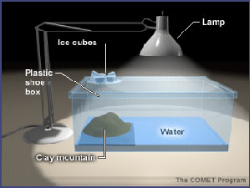 |
NASA | GSFC | JPL | Site Map |
|
|
 |
 |
Education: Student Outcomes |
Filtered by outcome, asset type: 0-4q3, activity Click here to begin a new search | |||||||||
Outcome: Describe the connections between the salt water found in the ocean and the fresh water in the water cycle. | |||||||||
Grade level: K-4 Theme: ocean circulation Activity: http://aquarius.nasa.gov/water_cycle.html
Water can change states among liquid, vapor (gas), and ice (solid) at various stages of the water cycle. Temperature affects the change of water from one state to another. When water vapor gets cold it changes to a liquid. This is called condensation. When heat is applied to water, it changes from a liquid to a gas. This is called evaporation. This activity will focus specifically on two aspects of the water cycle: evaporation and condensation. Key Concepts Evaporation occurs when a liquid is changed into a gas.
Evaporation occurs when the temperature of a liquid is increased.
Condensation occurs when a gas is changed into a liquid.
Condensation occurs when the temperature of the vapor decreases.
When the sun heats up water in rivers, lakes or the ocean, it turns into vapor or steam. The water vapor or steam leaves the body of water and goes into the air. Background The water cycle has no starting point. But we'll begin in the oceans, since that is where most of the Earth's water exists. The sun, which drives the water cycle, heats water in the oceans. Some of it evaporates as vapor into the air. Ice and snow can sublimate directly into water vapor. Rising air currents take the vapor up into the atmosphere, along with water from evapotranspiration, which is water transpired from plants and evaporated from the soil. The vapor rises into the air where cooler temperatures causes it to condese into clouds. | |||||||||
